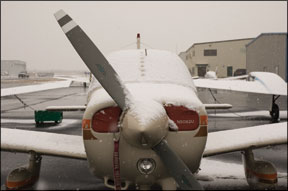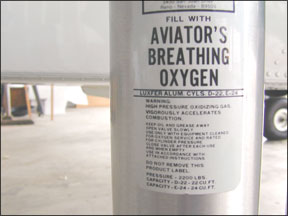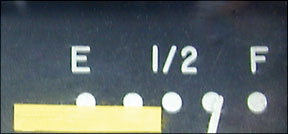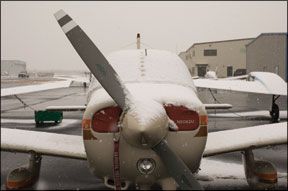Treat and well-illustrated article on the whys and hows of pre-heating (“Pre-Heating,” January 2010). I, too, have an Archer II (at MMU). I invested in the sump and heating bands, which is the best you can do if you are poor. A heated hangar here will cost you your first-born male child and a kidney. 288 However, I purchased a Makita one-kilowatt gas-driven generator. I leave it on my trucks tailgate, start it and plug in the bands and sump heater. I go back into the cab, have some coffee, do my pre-flight, and in 35 minutes, we are ready to go, assuming a 17-to-20 deg. F ambient temperature. If I am going to land and stay overnight, I bring the generator with me. It weighs about 35 lbs, and you have to tie it down so it doesnt move (it has gasoline in it). The Makita was about $1000 when I purchased it five years ago. There is now a lot of competition and there are nice units available starting at $500. When one considers the cost of the wear and tear on the engine, pre-heating is essential if you hope your engine sees its TBO. Thanks for a great magazine! I appreciate how much work it is to put together something like AS. Chris Anderson, Another Data Point As the pre-heating article said, the debate rages. My rule has been to not try to start the engine below 20 deg. F. The main reason is it probably will not start anyway due to battery limitations and strains on the starter. Recently, it started easily at 24 deg. Oil pressure comes up almost as quickly as in warmer temps. Many years ago we had a valve break (a previous Cherokee 180) and Mattituck did the rebuild. I specifically asked about scuffing or other damage since it had been started often in cold temperatures, and the mechanic said there was no sign of damage from lack of lubrication. I realize if the engine was turbocharged it might be a different story, but an O-360 in a Cherokee Archer is a low-tech design. Interesting article, and you provide a great magazine. David Grimm, There are almost as many pre-heating tricks and techniques as there are pilots and airplanes. Our central recommendation is to be aware of the need for pre-heating an aircrafts piston engine when temperatures drop. Our rule of thumb: If its cold enough to be bundled up on the ramp, its cold enough to pre-heat. There are many variables involving engine longevity, so we hesitate pointing to one practice or another as a guarantee an engine will make it to TBO without issues. Two exceptions? First, fly the engine often, long enough for it to reach and maintain its normal operating temperature. This works to evaporate any moisture in the engine and helps keep things lubricated. Secondly, change the oil often, and then fly the engine to make sure its circulated throughout. If in doubt, you probably need to change the oil. When youre headed out the door to the airport for an afternoon of flying, just remind your spouse that flying the airplane will help minimize costly engine problems. Night School Omission 288 I am a relatively low-time pilot who greatly enjoys reading Aviation Safety. I learn something useful every month. For example, I enjoyed Ray Leis review of night flying issues in “Night School” (January 2010), but was somewhat surprised no mention was made of using supplemental oxygen. The FAA continues to recommend supplemental oxygen use above 5000 feet at night. Even the relatively mild hypoxia that develops at or above 5000 feet can have a deleterious effect on vision. At night, we need all the help we can get! Thank you for a wonderful publication. Mark S. Barlow, M.D., Thanks for the memory-jogger. Youre absolutely right to note supplemental oxygen can be a huge boon in night operations. Weve noticed the difference ourselves and strongly recommend using O2 at night above 5000 feet msl, as you note. Fuel Counts Thanks for the excellent article on fuel totalizers (“Counting Gallons,” December 2009). Like many cars Ive driven over the years, the fuel gauges in our Cessna 210 tend to read full even after droning on for quite a while; then the fuel quantity shown tends to drop rather quickly, with the needles bouncing like mad. So the Shadin totalizer we installed is much more reliable. Most of the time. On one memorable two-hour trip, we topped off before departing Livermore, Calif., for Santa Monica. It was my turn to fly, and my pilot-husband and I have an agreement that the PIC does everything unless help is needed, so he fell asleep soon after takeoff. As usual, the tanks read full for over an hour, then began dropping. As we approached the southern end of the great San Joaquin Valley, I noticed the fuel levels 288 dropping dramatically, bouncing around between a quarter and a third, even though the Shadin said we had over 3 hours remaining. Before descending into the L.A. basin you have to fly over several large mountain ranges, with virtually nowhere to land. I got that something-wasnt-right-feeling and elected to turn around and make a precautionary landing at the last airport behind us. On the ground, as I walked over to the FBO, I turned around and saw to my shock that both fuel caps were off, lying on top of the wings, attached by their chains. We have the original fuel caps and they are not always easy to close, so they must have come off at some point, with most of our fuel escaping. We now always personally close the fuel caps ourselves. Crista Worthy, Final word on Patterns? The traffic pattern depicted on page 32 of Februarys issue is such a clear teaching tool, I wish I had it for my students. The Aeronautical Information Manual says the same thing, but is not drawn so clearly. Your artwork is the first I have seen that makes clear the (now controversial) way I was taught (in 1970) to enter uncontrolled traffic patterns when on the opposite side from the 45-to-downwind turn. From that side, I was taught enter the upwind leg at traffic pattern altitude, cross the departure end of the runway over the numbers, and enter the downwind just as a plane doing touch-and-goes would do. Keep these great articles coming. Your magazine sparks thought, and flying is a thinking game. Roger Ameden,
Via e-mail
Via e-mail
Seabrook, Texas
Via e-mail
Trumbull, Conn.




